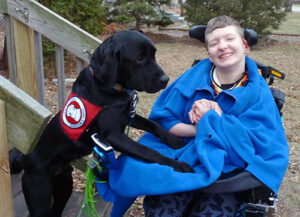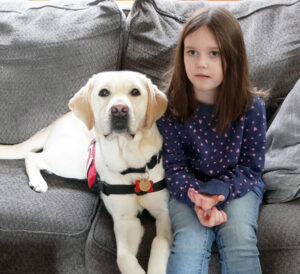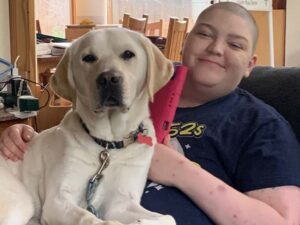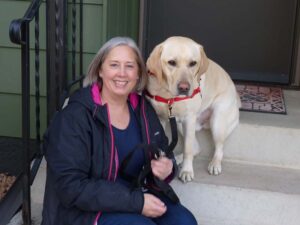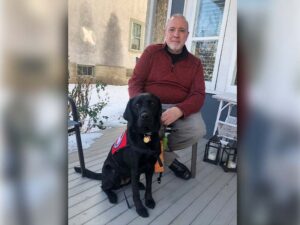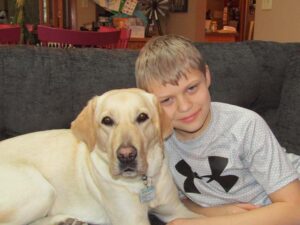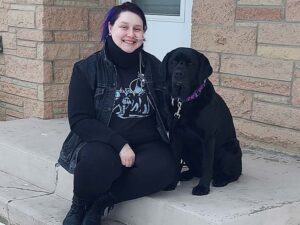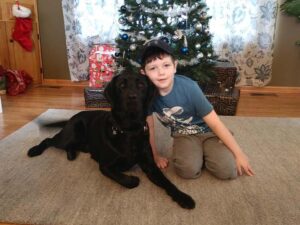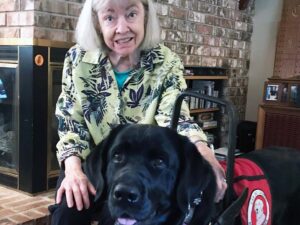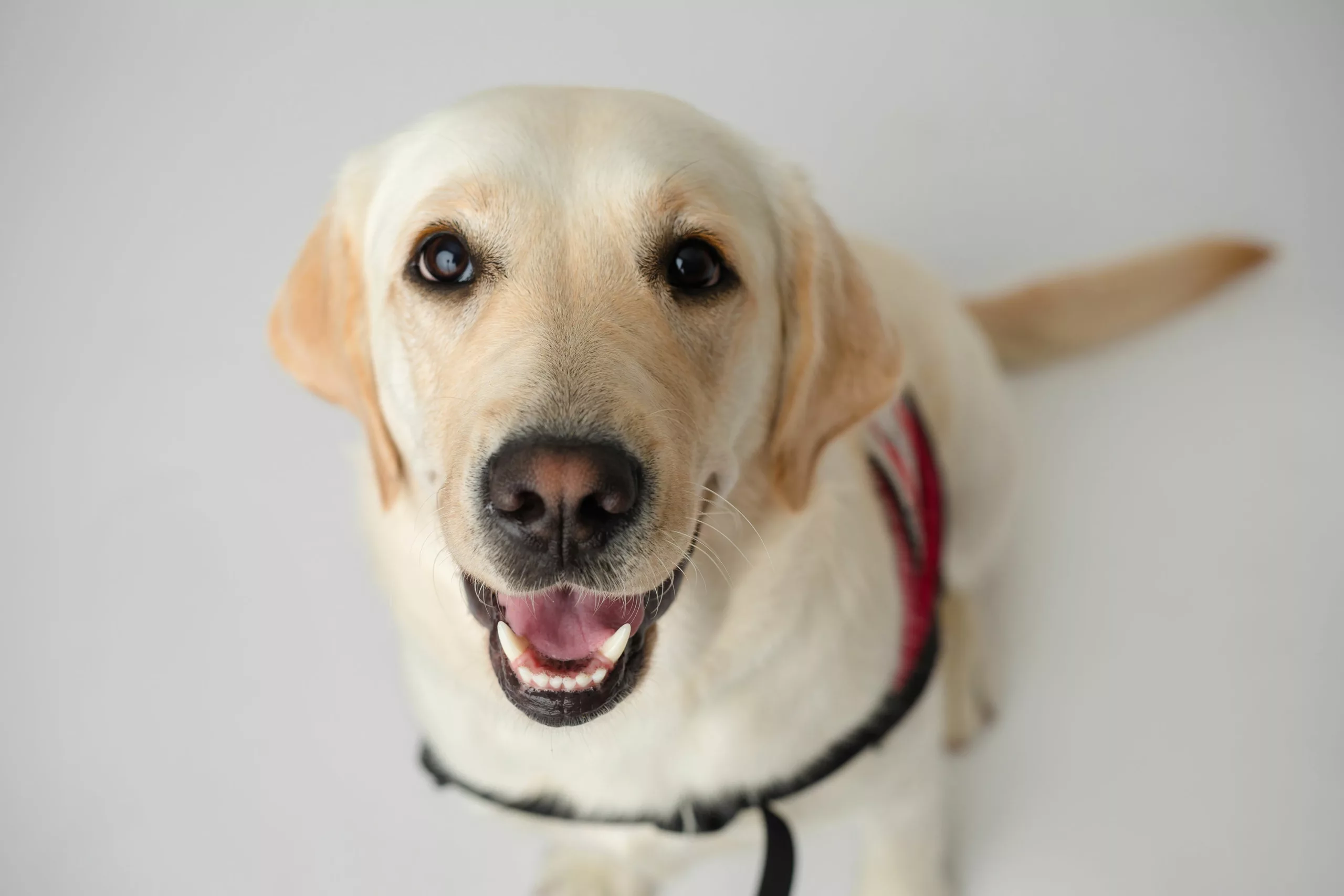Sarah has been involved in the Puppy Program in several different roles. Her most recent undertaking was as the rescue foster home for Edgar, a 1.5 year old Retriever Mix from the Animal Humane Society in Golden Valley who became a Can Do Canine in April. “I grew up not far from Can Do Canines so I frequently would pass by the building while on the highway,” Sarah says. She continues, “My mom and I attended a graduation event when I was in high school and that’s really when I learned about the organization and all that they did. It …
Feature Stories
Taking Independence to a Higher Level
Consider for a moment your dream home. Would it have an elevator? Fifteen-year-old Mike has an elevator that directly accesses his bedroom. But for Mike, who has cerebral palsy and uses a wheelchair, having elevator access is not a luxury; it’s a necessity. When Mike and his family took the steps to receive a Mobility Assist Dog from Can Do Canines, a special dog needed to rise to the occasion. An intelligent, black Labrador Retriever named Maddox was down with the plan to perform the specific skills to help Mike navigate the world. Although ecstatic to welcome a new buddy, …
Escaping Into a World of Greater Freedom
What the term “eloping” means for one family may be entirely different for another. David and Stacey regularly worried that their daughter, Braylee, would elope. Braylee is 8 years old, so she’s not planning on getting married anytime soon. She is on the autism spectrum though, and has a tendency to flee the safety of her caregivers—or “elope”—when in public sometimes. To prevent this, Braylee’s parents had her ride in a shopping cart or a stroller when out and about. As David explains, “When she has her feet on solid ground, she’s fast. And we’re getting slower.” As Braylee’s interests …
Where Medicine Failed, a Dog Fit
Disabilities don’t play by rules or follow textbook criteria. They often show up and cause issues beyond anyone’s expectations. Hannah has lived with a unique disability and conditions that complicate numerous aspects of her health, and traditional treatments have not been able to offer as many resolutions. At 13 years old, she was training for a half marathon and developed a pain in her left leg. It was discovered to be caused by a bone cyst, but its removal triggered her immune system to attack her muscles. She was eventually diagnosed with the refractory form of juvenile myasthenia gravis, a …
Familiar with the Process; Still Delighted with the Results
Janet isn’t new to Can Do Canines, she’s an alumni! In 1997, Janet received her first Hearing Assist Dog from Can Do Canines (then Hearing and Service Dogs of Minnesota). Tiger, a Border Collie mix, was her faithful partner, alerting her to important sounds for 13 years until he passed away in 2010. Years passed, with work, family and friends keeping her busy. In 2019, Janet found herself alone more and felt insecure. Her husband, Pat, often worked nights, and now that her daughter, Angela, was grown and working as well, she felt vulnerable not being able to hear. Janet …
From Selling the Dream to Living it
An expert in business and beer, Dan steered his role as a leader in executive management to focus on his passion by opening a distillery several years ago. With a diagnosis of Parkinson’s disease and its progress of over 15 years, however, he went from managing a business to managing a disability. Experiencing tremors in his hands, stiff muscles, constant pain, and severe balance issues, Dan lost much of his independence. While his life shifted away from his regular adventures, he persevered in caring for himself and his family with the help of surgeries and new technology. Dan would go …
The Journey of Fear to Friendship
Gavin deals with a disability that is more than what meets the eye, especially considering eye contact has been a challenge for him. At 5 years old, Gavin was diagnosed with autism, after spending several days testing at Mayo Clinic. His mother, Jenny, didn’t know other children with autism, but some resources at Mayo had suggested an autism assistance dog. Then, a family friend who was involved with Can Do Canines introduced Jenny to this organization. Gavin had been initially fearful of dogs, but during the application process time period, he began reading to a therapy dog at school and …
Katy’s Freedom Seemed on Thin Ice Before Meeting Iceley
Sometimes assistance dogs are named without their characteristics affecting the process. As fate would have it, Newfador (a Newfoundland and Labrador Retriever mixed breed) Iceley fits her name perfectly. Iceley embraces winter, even considering that her warm and affectionate personality might melt the snow beneath her sizable paws. Katy, who started training with the Mobility Assist Dog from Can Do Canines in September 2020, states, “Her name is really appropriate, because she absolutely adores running around and playing in the snow.” As any Midwestern knows, though, ice can also be treacherous. When difficult or dangerous situations arise for Katy—outside or …
A Partnership that Was Meant to Be…for So Many Reasons
When Megan and Ryan began looking into assistance dog organizations to apply for a dog for their son, Nolan, several years ago, friends suggested they put their name on multiple waiting lists. Megan knew the practicality of that approach, but admitted she only wanted to work with one. “I really heard amazing things about Can Do Canines,” she remembers. So they decided, “If it’s meant to be, it’s meant to be.” This past fall, fate gave them that answer, as Nolan was matched with a fun-loving black Labrador Retriever, Nitro. And it didn’t take long for the family to begin …
Mobility Assist Dog Issa Invites Bette to “Lean on Me”
It’s easy to see why Newfadors—dogs that are a hybrid of Newfoundland and Labrador Retriever breeds—often make perfect Mobility Assist Dogs. They’re big. They’re strong. They’re responsible. And they love to work. So in Fall 2020, a beautiful, black Newfador named Issa (as in “Melissa”) became the perfect assistance dog for Bette, from Hastings. Diagnosed with Parkinson’s disease 20 years ago, Bette struggles with mobility, dexterity and balance. She says, “It affects practically every aspect of my life.” Bette uses a cane to walk, but says of the way she sometimes used to make her way across a room, “I …


